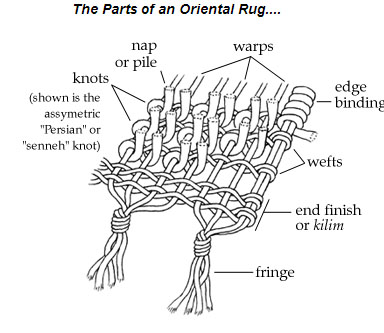Before I could even begin to learn about rugs, carpets and tapestries I had to first learn something about  the terms used in talking and writing about them. I discovered I had used many of these terms before without really understanding where they came from.
the terms used in talking and writing about them. I discovered I had used many of these terms before without really understanding where they came from.
Books On Oriental Rugs At The Kindle Store–Some as cheap as 1 Cent but surprisingly informative!
Take the two terms Warp and Weft. Have you ever used them together? I had with only a vague notion of what the words meant apart from each other. Together they make one of civilization’s great metaphors. To the point: Frank Lloyd Wright spoke of Architecture as “…the warp and woof of civilization …”
WARP: Wool, cotton, or silk strands of fiber attached to a Loom vertically for the entire length of a rug. Warps comprise the main structure of the rug, and are the yarns upon which the knots are tied.
WEFT: (Also Woof) The horizontal threads interlaced through the warp in a woven fabric. The weft threads hold the pile knots in place.KNOTS: A knot is formed when wool, cotton or silk yarn is looped around the warp threads.
PILE: The visible wear surface of carpet consisting of yarn tufts in loop and/or cut configuration. Sometimes called “face” or “nap.” The part of the carpet that comes face to face with your feet.
EDGE BINDINGS: are made by wrapping several warps at the edge of the rug with yarn to reinforce this part of the rug.
KNOTS: as you can see the “knots” are really convoluted loops, nothing that a sailor would want to use.
FRINGES: are formed by gathering and knotting together bundles of warp strings at both ends of the rug after the rug has been cut from the loom. The knots in these bundles of warp strings keep pile knots and end finishes tight at the rug’s ends. Look a bit like Cowboy Fringes but are more useful.
END FINISHINGS: hold knots and wefts from working off the rug’s warp strings. Also often referred to as the SELVEDGE (uk) or SELVADGE (USA).
more about end finishings taken from the Wikipedia article defining Selvages.
Selvages of fabrics formed on weaving machines with shuttles, such as hand looms, are formed by the weft turning at the end of each pick (pass of the weft thread) or every second pick. To prevent fraying, various selvage motions (or “styles”) are used to bind the warp into the body of the cloth. Selvages are created to protect the fabric during weaving and subsequent processing (i.e. burnishing, dyeing and washing) but ideally should not detract from the finished cloth via ripples, contractions or waviness.[2]
In handweaving the selvage is generally the same thickness as the rest of the cloth, and the pattern may or may not continue all the way to the edge, thus the selvage may or may not be patterned. A plain weave selvage is the other option, where the last few threads on either side are woven in plain weave.
KILIM/GHILIM: kilim or ghilim as shown in the above image is actually the term for the flat weave (no knots) that often form the end piece. This can be confusing as a KILIM is also an entire flat-woven rug.
Leave a Reply